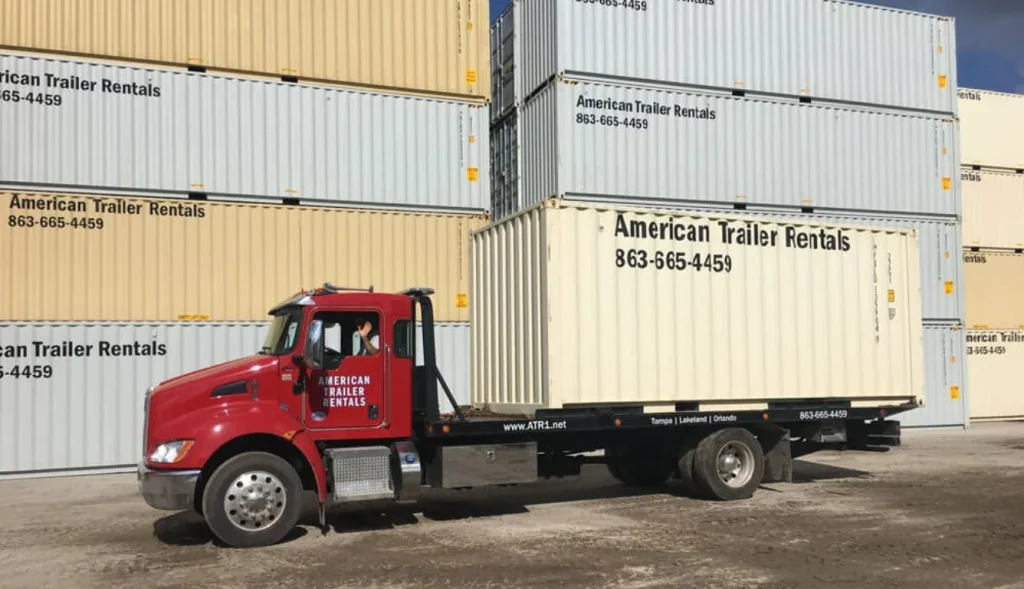Introduction
Transporting a shipping container might sound straightforward, but it involves several steps and considerations to ensure everything goes smoothly. Whether you’re relocating, managing logistics, or moving goods, understanding the process is key. This guide will walk you through the essential steps of transporting a shipping container, covering everything from planning and preparation to the actual transport and storage.

Planning for Container Transport
Assessing Container Size and Weight
Before you start arranging transportation, it’s crucial to assess the size and weight of your container. Shipping containers come in various sizes—commonly 20 feet and 40 feet long—and can be quite heavy when fully loaded. Knowing these details helps in choosing the appropriate transport method and ensures you comply with weight regulations.
Choosing the Right Transport Method
The transport method you choose depends on several factors, including distance, destination, and budget. Each method—road, rail, sea, or air—has its advantages and specific requirements.
Legal Considerations and Permits
Different regions and countries have specific regulations regarding the transport of shipping containers. Ensure you acquire the necessary permits and comply with local laws to avoid fines and delays. This includes weight limits, route restrictions, and customs requirements.
Preparing the Shipping Container
Inspection and Maintenance
Before transport, inspect the container for any damage and perform necessary maintenance. A well-maintained container ensures the safety of its contents and reduces the risk of damage during transport.
Securing the Contents
Properly secure the contents of the container to prevent shifting or damage. Use appropriate packing materials and secure items with straps or braces. This step is crucial for maintaining the integrity of the cargo and ensuring safety.
Ensuring Proper Loading
Loading the container correctly is essential. Distribute the weight evenly to avoid tipping and ensure that the container is balanced. Follow best practices for loading to facilitate smooth transport and unloading.
Transport Methods
Road Transport
Flatbed Trucks
Flatbed trucks are often used for transporting containers over shorter distances. They are versatile and can handle different container sizes. Ensure the truck is equipped with the necessary equipment to secure the container.
Specialized Container Trucks
For longer distances or specific requirements, specialized container trucks are a better choice. These trucks are designed to handle containers securely and efficiently, providing a smoother transport experience.
Rail Transport
Freight Trains
Rail transport is ideal for long distances across land. Freight trains can carry multiple containers simultaneously, making it a cost-effective and efficient option for bulk transport.
Rail Container Services
Some rail services specialize in container transport, offering additional features such as tracking and scheduled services. This can be beneficial for managing logistics and ensuring timely delivery.
Sea Transport
Container Ships
For international transport, container ships are the most common method. They can carry large quantities of containers and are equipped to handle the demands of sea travel.
Ports and Docking Procedures
Proper handling at ports and docks is crucial. Ensure that you follow the procedures for loading and unloading, including customs clearance and documentation.
Air Transport
Air Cargo Services
Air transport is the fastest method for international shipments. However, it’s usually more expensive and is best suited for high-value or time-sensitive cargo.
Logistics and Handling
Air cargo requires careful logistics and handling. Ensure you coordinate with the airline and follow their guidelines for container transport to avoid any issues.
Loading and Unloading
Loading Procedures
Proper loading techniques are vital for safe transport. Use cranes or forklifts as needed and ensure the container is securely fastened to prevent movement during transit.
Unloading Procedures
Unloading should be done carefully to avoid damaging the container or its contents. Follow the proper procedures and use appropriate equipment for unloading.
Safety Precautions
Always prioritize safety during loading and unloading. Wear protective gear, follow safety guidelines, and ensure that all equipment is in good working condition.
Handling and Storage
Temporary Storage Solutions
If the container needs to be stored temporarily, consider options such as storage yards or warehouses. Ensure the storage area is secure and suitable for the container.
Long-Term Storage Considerations
For long-term storage, choose a facility that offers adequate protection from weather conditions and potential theft. Regularly inspect the container to ensure its condition remains good.
Costs Involved
Transport Costs Breakdown
The cost of transporting a shipping container can vary based on the method, distance, and other factors. Obtain quotes from different providers and consider all aspects of the transport, including loading, unloading, and any additional fees.
Additional Fees and Charges
Be aware of potential additional fees, such as customs duties, port fees, and handling charges. These can add up and affect your overall budget.
FAQs
How do I choose the best transport method for my container?
Consider factors such as distance, budget, and the nature of the cargo. Road transport is suitable for shorter distances, while rail and sea transport are better for long distances. Air transport is ideal for high-value or urgent shipments.
What are the typical costs for shipping container transport?
Costs vary depending on the transport method, distance, and additional services. Obtain quotes from different providers and factor in all potential fees and charges.
How can I ensure my container is loaded securely?
Use proper loading techniques and equipment to secure the container and its contents. Distribute weight evenly and use straps or braces to prevent movement.
Are there any special requirements for transporting containers internationally?
Yes, international transport requires compliance with customs regulations, permits, and documentation. Ensure you follow all guidelines to avoid delays and fines.
What should I do if my container gets damaged during transport?
Document the damage and contact your transport provider immediately. They should have procedures in place for handling such issues and may offer compensation or repairs.
Conclusion
Transporting a shipping container involves careful planning and execution. By assessing the size and weight of the container, choosing the right transport method, and ensuring proper preparation, you can facilitate a smooth and efficient transport process. Whether you opt for road, rail, sea, or air transport, understanding the procedures and costs involved is essential for successful shipping.


Congratulation!